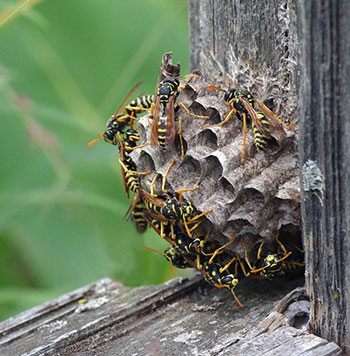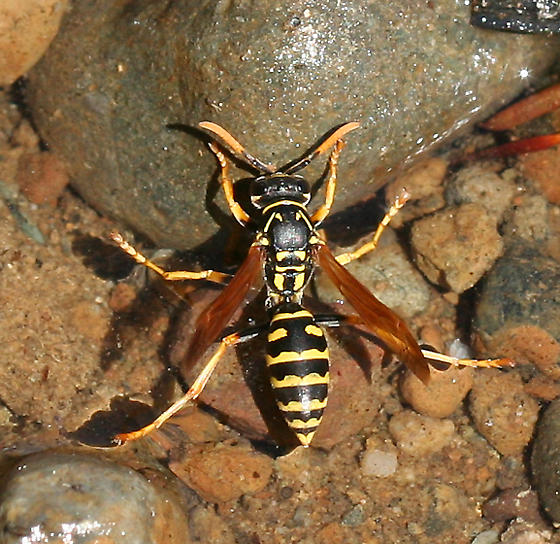Polistes dominula BIO 203
 Habitat
Habitat
Polistes dominula can be found in many regions of the world. Its primary domain exists in a broad expanse that encompasses much of Europe, the Middle East, and northern Africa. In Europe, P. dominula can be found around in areas that harbor a climate that is considered marine west coast or humid continental (Encylopedia of Life 2013). The primary countries this includes are Germany, France, Spain, Italy, Turkey, and Ukraine. Through the Middle East, P. dominula can be found in Iraq, Iran, Afghanistan, southern Kazakhstan, and Pakistan. The countries in northern Africa where it can be found are Morocco, far northern Algeria, north Tunisia, and Egypt along the Nile River. These regions in the Middle East and Africa where P. dominula presides all have a semiarid to arid climate (Cervo et al. 2000).
The humid continental climate P. dominula thrives in has a large contrast of seasonal temperatures. This climate region mainly can be found between 30 and 60 degrees north latitude. There is a clear line between the four seasons – summer, fall, winter, and spring – by which expected temperatures and precipitation fall upon. Depending on location in this climate, precipitation has an average that is between 50cm and 125cm per year. Throughout the summer, precipitation presents itself through thunderstorms and hurricanes or cyclones depending on the continent. When winter finally comes around, precipitation can be either in the form of rain or snow depending on how far north an area is (Encyclopedia Britannica 2013, Ritter 2013).
The Mediterranean
climate P. dominula lives in is much more uniform than that of
the humid continental climate. It can only be found around the
Mediterranean Sea and is between 30 and 45 degrees north latitude. This
climate is characterized by summers that are hot and dry with winters
that are cooler and relatively wet. Precipitation mainly is rain unless
at a higher elevation in which it occurs in the form of snow. On
average, the area in this clim ate sees between 35cm to 90cm of
precipitation (Encyclopedia Britannica
2013, Ritter 2013).
ate sees between 35cm to 90cm of
precipitation (Encyclopedia Britannica
2013, Ritter 2013).
P. dominula can be found in spots that are considered to be part of a semi-arid climate. As mentioned above, this includes the Middle East as well as the far northern reaches of Africa. Summers are often very hot and winters remain rather mild due to location. The cold polar air the Mediterranean and humid continental climates see is simply not able to make it into this region. Precipitation for this climate is sparse. Average rainfall is between 25cm and 51cm per year. It normally comes with the monsoons that sweep through during the winter months and exists almost exclusively in the form of rain (Encyclopedia Britannica 2013, Ritter 2013).
The P. dominula wasp has an incredible ability to take over new areas due to a variety of different characteristics. In North America, foundresses and co-foundresses of a colony emerge in the spring as temperatures start to be conducive of life once again (Jacobs 2011, Liebert et al. 2006). This happens earlier than other competing species, which gives them an edge against predators. Larvae are already full grown adults by the time other species are starting to emerge, thus predators go for the easy kill of other species like P. fuscatus. (Jacobs 2011, Liebert et al. 2006).
Due to its immense ability to colonize very fast, it is not a surprise that P. dominula is an invasive species in parts of North America near urban areas. At the beginning of the 1970’s, the first noticeable sightings of P. dominula were first noted and looked into. By 1999, it had already spread all the way across the United States to the West Coast. The primary climate that P. dominula resides in North America is humid continental. This rapid spread was confirmed by a study that was performed in 1993. In this study, year one began with only 18 colonies, but by the end of year two, there was a massive increase in numbers of colonies as 136 were counted (Cervo et al. 2000).
Colonies of P. dominula are more commonly found near areas of urban development due to fragmentation of nearby land (Liebert et al. 2006). Because man-made structures create a great opportunity to hide from predators, they are often colonized, which leads to more interactions with humans. Common places nests are made include eaves of various structures, attics, voids in walls, bird houses, parking meters, lighting fixtures, and even animal skulls (Please check out the reproduction page for more information about nest building)(Jacobs 201, Liebert et al. 2006).